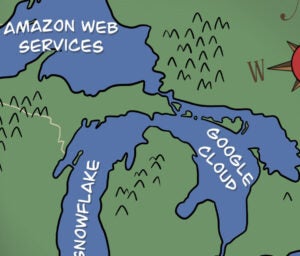 “Data Driven Thinking” is written by members of the media community and contains fresh ideas on the digital revolution in media.
“Data Driven Thinking” is written by members of the media community and contains fresh ideas on the digital revolution in media.
Today’s column is written by Sacha Xavier, Partner, Media & Innovation Director for Neo@Ogilvy.
2013 has evolved with bigger and more celebrity-laden digital upfronts, also known as “New Fronts.” I hesitate to even call them New Fronts because, much like the term “new media,” there will come a time in the very near future when they’re not new anymore.
I had the pleasure of attending a few and would like to offer some food for thought, peppered with a few opinions.
Much like last year, the New Fronts featured new and original made-for-web programming, which makes me wonder: whatever happened to all the digital programs that were debuted last year? Also like last year, many of these programs look really exciting, but in a world where people don’t realize their TV is connected, will these programs catch on or is it too soon? I applaud those upfronts that address the core of a media company’s business – whether it is plain old ad banners or content channels. At the same time, I am cautiously optimistic about the major publishers who never said the word “banner” once at their upfront.
What I’m trying to say is that some (not all) pure-play digital properties are positioning themselves similarly to TV by emphasizing original programming. It’s obvious that some of these publishers realized that last year they spent 99% of their upfront time talking about 1% of their business, given that some made the choice to showcase all-new programming last year, but then went back to calling a spade a spade this year.
The above observations lead me to another question: does digital media ever need to be bought upfront? At one of the upfronts I attended, I witnessed a cheesy “just sold to the guy in blue” tactic. After we were shown a sizzle reel of their upcoming original programming, they announced that an agency had just bought the entire channel. That was about as staged as a pregnancy test scene on a reality show. Did someone really bring an Insertion Order to the party?
In my 14 years in digital media, scatter and targeted “spot” (although we never refer to it as either scatter or spot) have been the way we buy. Sure, there are upfront deals for annual contracts, but generally speaking, the beauty of digital has always been the ability to buy media closer to the actual run, thus having flexibility to be dynamic. And it need not be programmed. We as digital marketers have cracked the code on programmatic buying through sophistication in buying technology; therefore, this type of programmed buying has an entirely different meaning online. Back in the day (circa 2002), portals were selling homepage placements and “keywords” on portals a year in advance. With those days seemingly gone, are these events one long, overproduced exercise in gaining incremental revenue?
A few additional thoughts:
We might be a little early to go backward. I love connected TV. I have one myself. I realize that many TVs are being sold this way, and I think that’s terrific; it can help all of these original programs totally take off and change the Web. I don’t actually watch anything that is made for Web, but I’m not opposed to it. Problem is, I’m a minority in the tech category. The average consumer has no idea what the above sentence even means.
Don’t forget who keeps your lights on. We love to see new things. We would actually be miserable if we didn’t see anything new. But if your main profit center is ad banners or user-generated content, they should be showcased on a pedestal at your upfront. To just abandon the spoon that feeds you seems not only wrong but a little disingenuous.
As far as buying truly upfront, the verdict is still out. We have several brands that we do buy in advance for various reasons, and we gain significant savings for doing so. The upfronts this year did not compel me to make this a standard practice. I’m open to it, although I will miss the flexibility. And what else will I do all year?
Follow Sacha Xavier (@sachaxavier) and AdExchanger (@adexchanger) on Twitter.













